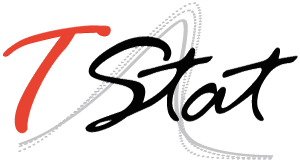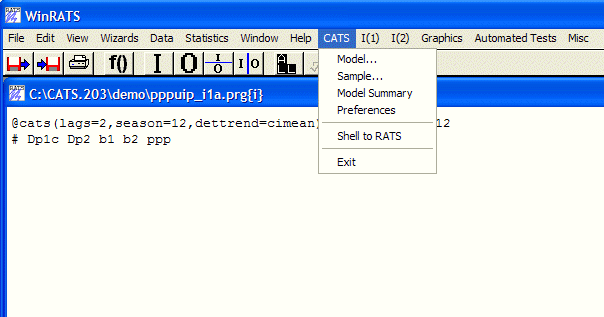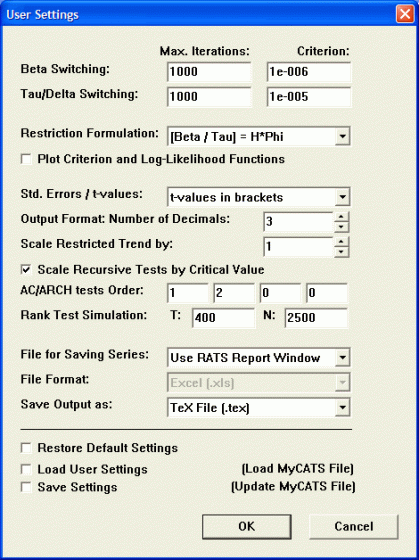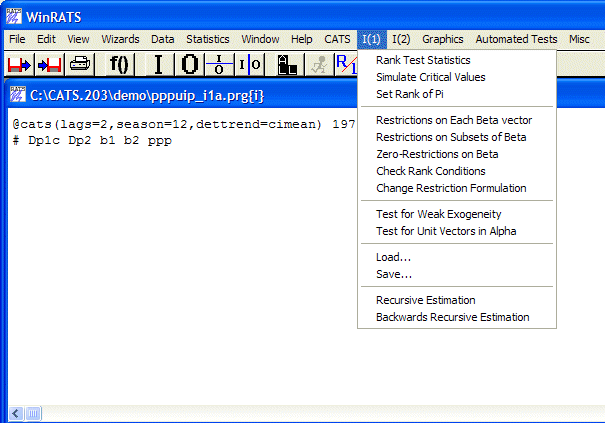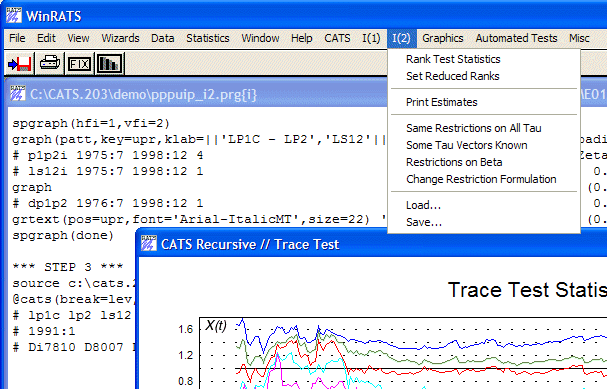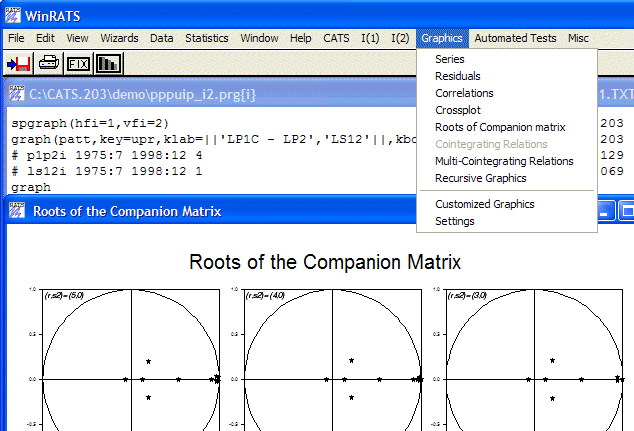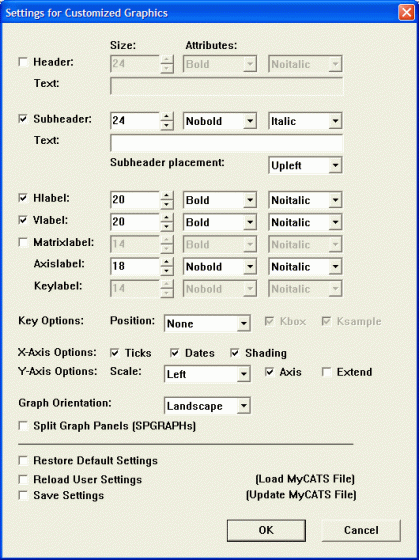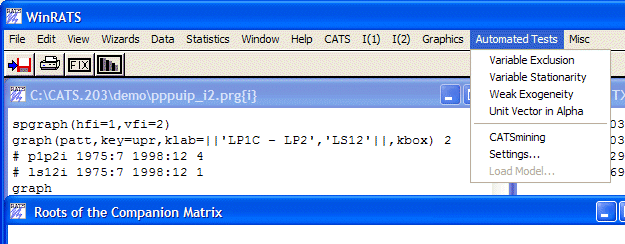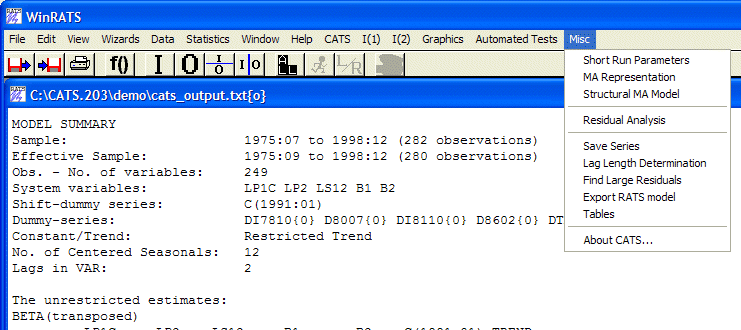

CATS (Cointegration Analysis of Time Series) is a set of cointegration analysis procedures written by Jonathan G. Dennis, Katarina Juselius, Sören Johansen and Henrik Hansen of the University of Copenhagen for use with our RATS software.
CATS provides a wide variety of tools for analyzing your data and choosing and testing a cointegration model. The program is almost completely menu- and dialog-driven. You begin by running a short RATS program to define your data and load the CATS procedure. This adds several CATS menus to the RATS menu bar, and you perform your analysis by selecting operations from these menus. CATS will prompt you for any needed input.
Version 2.0 is a major update to CATS that introduces significant new econometrics capabilities, a re-designed and expanded user interface, and a new, significantly expanded User’s Manual.
NEW ECONOMETRICS FEATURES
OTHER FEATURES These features carry over from Version 1.0:
|
NEW INTERFACE FEATURES
|
THE CATS MENUS
While Version 1 of CATS used a single pull-down menu, Version 2 of CATS has six different menus, providing access to its much broader range of capabilities and many new features.
|
To give you a better idea of what you’ll find in Version 2, we’ll walk through the various menus, starting with the first menu, entitled CATS, which is shown below:
Most of the features on this menu are new in Version 2.0, and allow you to make adjustments without having to quit and restart the CATS procedure. They also give the user more control over many aspects of the program than in Version 1.
For example, you can change the model (including the deterministic variable structure, the inclusion of seasonal dummies, and the lag structure), control the sample range (by setting starting and ending dates, using a sample “dummy” series, or directly excluding specific observations), display a summary of the model, or set any of the following preferences:
HERE IS THE I(1) MENU
Most of these options will be familiar to those of you who have used CATS 1.0. These form the core functionality of the I(1) analysis capabilities in CATS 2.0, which includes determining and setting the cointegration rank and testing hypotheses on the structure of the elements of the Pi matrix.
Here is the I(2) menu
I(2) analysis is a new feature in CATS 2.0. The menu operations allow you to set the ranks of the model, test restrictions on both the Tau and Beta matrices, and more.
|
HERE IS THE GRAPHICS MENU:
As you can see, the Graphics menu provides quick access to a wide selection of graphs. In addition to offering more graphs than were available in CATS 1.0, Version 2 also allows the user to customize the appearance of the graphs. The “Customized Graphics” operation toggles between the default settings, and your customized settings, which you access via the “Settings” operation:
THE AUTOMATED TESTS MENU As the name implies, the Automated Tests menu provides access to several important tests, most of which CATS can perform with little or no input required from the user. Here’s the menu:
Most of these are fairly self-explanatory. One major new feature is the CATSmining operation. The name is a twist on the phrase “data mining”, implying an automated routine for analyzing data. In this case, the CATSmining routine can automatically identify and restrict the cointegrating space, given a user-specified cointegrating rank. You also have the option of supplying user-defined relations to be used in addition to those selected by the automatic procedure. The Settings operation gives you control of many aspects of the CATSmining process.
Finally, the Load Model operation allows you to load into memory a CATS model saved in a previous session (the ability to save and reload models is new in Version 2).
THE MISC MENU The Misc menu (short for miscellaneous) provides ten more useful features:
The first two display the short run and MA representations for the current model.
The next item, Structural MA Model, is a major new addition that allows you to define a structural model and plot the resulting impulse response functions.
Other operations allow you to save the generated data to various types of file (or display the data in a spreadsheet-style window), save the model for use in a later session, and more.
|
La invitiamo a leggere attentamente le condizioni d’uso del software CATS
| SINGLE-USER LICENSE AGREEMENT
You may use the software on any compatible computer, provided you use it on only one computer at a time. For instance, you can install it on both a home computer and an office computer. Or you may use the software on a network or file server provided that access is limited to one user at a time.
Limited Warranties. 1. Estima does not warrant that the program will meet your requirements, or that operation of the program will be uninterrupted or error-free. Estima, however, warrants the media on which the program is furnished to be free from defects in materials and workmanship under normal use for a period of ninety(90) days from the date of delivery to you, as evidenced by a copy of your receipt. Your exclusive remedy for breach of this warranty shall be the replacement (without charge to you) of a disk not meeting Estima’s warranty. 2. Estima makes no other warranties, either express or implied, and Estima shall not be liable for implied warranties of merchantability and fitness for a particular purpose, nor for the special, incidental, or consequential damages such as loss or profits or inability to use the software. The remedy for breach of this warranty shall be limited to replacement of the media.
Governing Law. This license is governed by the laws of the State of Illinois and the United States of America. |
MULTIPLE-USER/NETWORK LICENSE AGREEMENT
Multiple User/Network License. This is a multiple user/network license. You (the Licensee) may (a) install this on the number of computers indicated by the User Limit, solely for use by your employees (and your students if you are an institution of higher learning), or (b) install this on a single local area network provided the number of simultaneous users is limited to the User Limit. If the User Limit is “Unlimited”, you may do both. As this is a perpetual license, you are responsible for seeing that the software is removed from computers installed under option (a) when the computer no longer is in the possession of an employee or student. Should there be users (such as students) for whom enforcement of this would be difficult, you can obtain install disks for the software from Estima that are time-limited. Copies of the program installed with these would still count against your User Limit, but only for the time during which the program would be activated.
Limited Warranties: 1. Estima does not warrant that the program will meet your requirements, or that operation of the program will be uninterrupted or error-free. Estima, however, warrants the media on which the program is furnished to be free from defects in materials and workmanship under normal use for a period of ninety(90) days from the date of delivery to you, as evidenced by a copy of your receipt. Your exclusive remedy for breach of this warranty shall be the replacement (without charge to you) of a disk not meeting Estima’s warranty. 2. Estima makes no other warranties, either express or implied, and Estima shall not be liable for implied warranties of merchantability and fitness for a particular purpose, nor for the special, incidental, or consequential damages such as loss or profits or inability to use the software. The remedy for breach of this warranty shall be limited to replacement of the media.
Governing Law. This license is governed by the laws of the State of Illinois and the United States of America. |
FRED Database Access
This product uses the FRED® API but is not endorsed or certified by the Federal Reserve Bank of St. Louis. Data series available through the FRED® API, may be owned by third parties and subject to copyright restrictions. Although the FRED® API allows RATS to access FRED®, ALFRED® , or other data series, neither the Federal Reserve Bank of St. Louis’s provision of the FRED® API to Estima, or Estima’s inclusion of the FRED® API in RATS, override the data series owners’ copyrights, requirements and restrictions. You are solely responsible for complying with any requirements or restrictions imposed on usage of the data series by their respective owners.
The Professional version adds the X12 Census Bureau seasonal adjustment procedure and enhanced database access features, including ODBC/SQL data access, support for reading and writing FAME format database files, and the ability to read CRSP data.
WINRATS:
WinRATS runs on all recent versions of Windows, including Windows 10, 8, 7, Vista, and XP, in either 32-bit or 64-bit. Here are the minimum system requirements:
- A PC with a Pentium or later processor
- Memory requirements will depend largely on the size of the data sets you need to work with. You will need approximately 1 Megabyte of RAM for every 128,000 data points. The RATS program itself is fairly compact, and only requires about 1 Megabyte of RAM to load.
- A hard disk drive with at least 200Mb of free disk space (for a full installation, including all examples, procedures, and documentation)
- Windows 10, 8, 7, Vista or XP
MACRATS:
MacRATS requires an Intel-based Mac and requires version 10.9 or later of OS X. It has been tested with all OS X upgrades through Hight Sierra (10.13).
- Any Macintosh capable for running OS X 10.9 or later.
- OS X 10.9 or later
- Memory requirements will depend largely on the size of the data sets you need to work with. You will need approximately 1 Megabyte of RAM for every 128,000 data points. The RATS program itself is fairly compact, and only requires about 1 Megabyte of RAM to load.
- A hard disk drive with at least 175Mb of free disk space (for a full installation, including all examples, procedures, and documentation)
RATS FOR UNIX AND LINUX
RATS is available for most UNIX-based workstations, including Sun, HP, and IBM systems. Estima also support Intel-based PC’s running Linux. (It is also possible to compile and run our UNIX version on Macintosh OS X systems, but most Mac users will prefer to use MacRATS, which is written specifically for the Mac OS X operating system).
For most of these, RATS is shipped as C and C++ language source code, which must be compiled on the target machine with an ANSI-standard C/C++ compiler. The Linux version is provided as a pre-compiled executable, with the source code available as an option.
The UNIX and Linux versions support essentially all of the features offered in the Windows and Macintosh versions, including the complete interactive mode “RATS Editor” interface. In order to use the interactive interface, your system must support X Windows, and GTK libraries must be available if you need to compile the source. With version 9, we switched from using the older Motif to the more modern and better-supported GTK.
SYSTEM REQUIREMENTS:
- Processor: virtually any CPU running UNIX; Intel Pentium-based or later PC running Linux; a Macintosh running Mac OS X (PowerPC or Intel CPU)
- An ANSI-standard C/C++ compiler (optional for Linux)
- GTK libraries (not required for batch mode operation)
- Disk Space: 250Mb of available space for a full installation, including documentation and examples
- Memory Requirements: depends largely on the size of the data sets that will be used.
REQUIRES RATS 6.2 OR LATER
Note that you must have a copy of the RATS software in order to use CATS. CATS 2.0 will work with Version 6.2 or later of RATS.
CATS DOCUMENTATION: THE COINTEGRATED VAR MODEL AND ACCOMPANYING HANDBOOK
CATS 2.0 was developed in conjunction with the creation of the book The Cointegrated VAR Model by Katarina Juselius. Although the book is certainly not required to use CATS, we think anyone interested in cointegration analysis, and particularly anyone using CATS to do cointegration analysis, will find it extremely helpful.
PROCEDURES AND EXAMPLES
The Procedures and Examples Page provides access to over a thousand existing RATS procedures and example programs you can download for your own use. Note that if you have a current copy of the program, most of these will already be loaded onto your computer, but the web-based browser may make it easier to find an example for a particular technique.
RATS DISCUSSION FORUM
Estima’s web-based RATS Software Forum is a useful venue for RATS users to exchange ideas, solve programming problems, discuss econometrics topics, and more. The support staff at Estima are active participants, frequently posting example code and procedures on the forums before they appear anywhere else.
See the RATS Discussion Forums page for more information.
NEWSLETTERS
Estima periodically publish a newsletter (called RATSLetter which describes updates to the software, resources available to users and tips both on econometric practice and the use of RATS. You can download PDF copies using the link shown.
SOFTWARE UPDATES
Estima occasionally posts patch files that allow licensed RATS users to download updates to more recent versions at no charge. See Software Updates for details.
KNOWN BUGS AND MANUAL ERRATA
If you are experiencing a problem with RATS, you may want to check the List of Known Bugs to see if it is something we know about and have fixed. Others may want to look over this list to see if any known problems might affect your work.
© 2025 Estima. All Rights Reserved.
CATS (Cointegration Analysis of Time Series) is a set of cointegration analysis procedures written by Jonathan G. Dennis, Katarina Juselius, Sören Johansen and Henrik Hansen of the University of Copenhagen for use with our RATS software.
